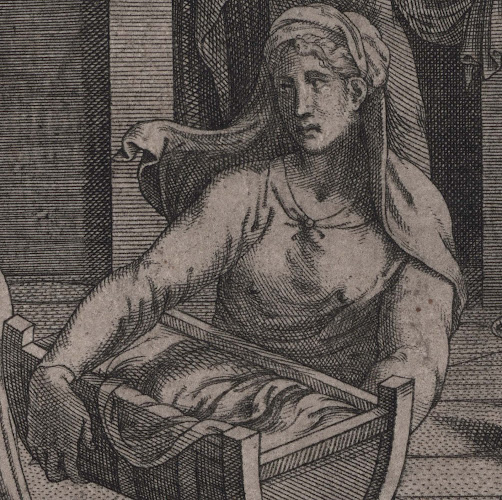Diana
Scultori (aka Diana Ghisi; Diana Mantovana) (1536–1598)
Note that the Curator
of the British Museum advises: “The authorship of this print is highly
contested. S. Massari considers it to have been done by Diana, while P. Bellini
considers it to be a dubious attribution. Other scholars have suggested that it
was made by C. Cort. See Paolo Bellini, ‘L'opera incisa Adamo e Diana
Scultori’, Vicenza, 1991, pp. 266-68” (BM inv. no. V,8.2).
“The Birth of John
the Baptist” (TIB title) (aka “La Naissance de St. Jean Baptiste”; “Geboorte
van Johannes de Doper”), c.1580, after a drawing by Giulio Romano (aka
Giulio Giannuzzi; Giulio Pippi) (c.1499–1546), published in Rome in c.1580 (between
1547–1612).
Engraving on
laid paper, trimmed around the image borderline and backed with a support
sheet.
Size: (sheet)
41 x 36.5cm.
TIB 31.26
(Suzanne Boorsch & John Spike [eds.] 1986, “The Illustrated Bartsch:
Italian Artists of the Sixteenth Century”, vol. 31, New York, Abaris Books, p.
266, cat. no. 26).
The Rijksmuseum
offers the following description of this print: (transl.) “In the background on
the right, Elizabeth lies in childbirth and is embraced by one of the women who
visit her. Angels hold up the canopy of her bed. In the front left, a group of
women are giving the child a bath. From a window in the back wall of the room,
God the Father watches the events” (http://hdl.handle.net/10934/RM0001.COLLECT.98903).
Diana Scultori
is an exceptionally important female figure in the Renaissance and her
significance is underlined by being the first woman to obtain the privilege (copyright) to sell her artworks under her own name. Interestingly Scultori
changed her name according to the power politics at play at the time with the
intention of attracting influential patrons. In short, Scultori’s skill as an
engraver, her strategic and flexible use of her identity and having a tight
rein on copyright—from memory (and I may be wrong about this) I believe that
Scultori even placed the first copyright on a cap design! (albeit a nightcap
for men that was decorated with a scene of Delft)—make her a true milestone
figure in the history of art.
Condition: a
strong and early impression (possibly lifetime impression based on the quality
of the line showing no sign of wear to the printing plate) trimmed around the
image borderline (following the curve of the upper edge) and laid upon a
support of archival (millennium quality) washi paper. The sheet has darkened (or
possibly the paper is grey) with many small restorations for fractures, tears
and losses, but there are no significant stains.
I am selling
this major engraving by one of the most important female artists
of the Renaissance period, for the total cost of AU$356 (currently US$235.19/EUR217.71/GBP181.44
at the time of this listing) including Express Mail (EMS) postage and handling
to anywhere in the world, but not (of course) any import duties/taxes imposed
by some countries. Note that payment is in Australian dollars (AU$356) as this
is my currency.
If you are
interested in purchasing this large engraving by arguably one of the savviest
business women in the arts during the Renaissance, please contact me
(oz_jim@printsandprinciples.com) and I will send you a PayPal invoice to make
the payment easy.
This print has been sold



























































